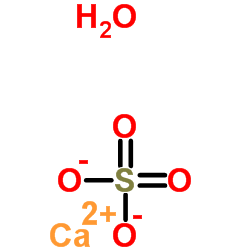10034-76-1
| Name | calcium sulfate hemihydrate |
|---|---|
| Synonyms |
CALCINED GYPSUM
Calcium sulfate hemihydrate CalciumSulphateDriedBp Calcium sulfate hydrate (1:1:1) EINECS 231-900-3 CALCIUM SULFATE 0.5-WATER CALCIUM SULFATE CALCINED CALCIUM SULPHATE 1/2 H2O Calcium sulfate,medicinal Dried gypsum PLASTER OF PARIS Calcium sulfate, hemihydrate GYPSUM |
| Boiling Point | 330ºC at 760mmHg |
|---|---|
| Melting Point | 1450ºC |
| Molecular Formula | H2CaO5S |
| Molecular Weight | 154.156 |
| Exact Mass | 153.924881 |
| PSA | 97.87000 |
| Stability | Stable. Hygroscopic. |
| Water Solubility | sets to hard mass when mixed with H2O [MER06]; g/100g solution H2O: 1.23 (0°C), 0.71 (25°C), 0.189 (100°C); solid phase, CaSO4 · 1/2H2O [KRU93] |
Synonym:Sulfuric acid calcium salt hemihydrat Section 2 - COMPOSITION, INFORMATION ON INGREDIENTS
Risk Phrases: None Listed. Section 3 - HAZARDS IDENTIFICATION EMERGENCY OVERVIEW
Not available. Potential Health Effects Eye: Causes eye irritation. May cause conjunctivitis. Skin: Causes skin irritation. Ingestion: Ingestion of large amounts may cause gastrointestinal irritation. Inhalation: Dust is irritating to the respiratory tract. Chronic: Prolonged inhalation may cause respiratory tract inflammation and lung damage. Section 4 - FIRST AID MEASURES Eyes: Flush eyes with plenty of water for at least 15 minutes, occasionally lifting the upper and lower eyelids. Get medical aid. Skin: Flush skin with plenty of water for at least 15 minutes while removing contaminated clothing and shoes. Get medical aid if irritation develops or persists. Ingestion: If victim is conscious and alert, give 2-4 cupfuls of milk or water. Never give anything by mouth to an unconscious person. Get medical aid immediately. Inhalation: Remove from exposure and move to fresh air immediately. If not breathing, give artificial respiration. If breathing is difficult, give oxygen. Get medical aid. Notes to Physician: Section 5 - FIRE FIGHTING MEASURES General Information: As in any fire, wear a self-contained breathing apparatus in pressure-demand, MSHA/NIOSH (approved or equivalent), and full protective gear. Extinguishing Media: Substance is noncombustible; use agent most appropriate to extinguish surrounding fire. Section 6 - ACCIDENTAL RELEASE MEASURES General Information: Use proper personal protective equipment as indicated in Section 8. Spills/Leaks: Vacuum or sweep up material and place into a suitable disposal container. Section 7 - HANDLING and STORAGE Handling: Use with adequate ventilation. Minimize dust generation and accumulation. Avoid contact with skin and eyes. Avoid ingestion and inhalation. Storage: Store in a tightly closed container. Store in a cool, dry, well-ventilated area away from incompatible substances. Section 8 - EXPOSURE CONTROLS, PERSONAL PROTECTION Engineering Controls: Use adequate ventilation to keep airborne concentrations low. Exposure Limits CAS# 10034-76-1: Personal Protective Equipment Eyes: Wear appropriate protective eyeglasses or chemical safety goggles as described by OSHA's eye and face protection regulations in 29 CFR 1910.133 or European Standard EN166. Skin: Wear appropriate protective gloves to prevent skin exposure. Clothing: Wear appropriate protective clothing to minimize contact with skin. Respirators: Follow the OSHA respirator regulations found in 29 CFR 1910.134 or European Standard EN 149. Use a NIOSH/MSHA or European Standard EN 149 approved respirator if exposure limits are exceeded or if irritation or other symptoms are experienced. Section 9 - PHYSICAL AND CHEMICAL PROPERTIES Physical State: Solid Color: white Odor: odorless pH: 6-7.6 for 20% soln. Vapor Pressure: Not applicable. Viscosity: Not available. Boiling Point: Not applicable. Freezing/Melting Point: 2642 deg F Autoignition Temperature: Not applicable. Flash Point: Not applicable. Explosion Limits, lower: Not available. Explosion Limits, upper: Not available. Decomposition Temperature: Not available. Solubility in water: 0.3% in water. Specific Gravity/Density: Not available. Molecular Formula: CaSO4. 0.5 H2O Molecular Weight: 145.15 Section 10 - STABILITY AND REACTIVITY Chemical Stability: Stable under normal temperatures and pressures. Conditions to Avoid: Incompatible materials, moisture. Incompatibilities with Other Materials: Calcium sulfate is incompatible with aluminum and diazonethane. At high temperatures, mixtures of calcium sulfate and phosphorus ignites. Hazardous Decomposition Products: Oxides of sulfur. Hazardous Polymerization: Has not been reported. Section 11 - TOXICOLOGICAL INFORMATION RTECS#: CAS# 10034-76-1 unlisted. LD50/LC50: Not available. Carcinogenicity: CALCIUM SULFATE HEMIHYDRATE - Not listed by ACGIH, IARC, or NTP. Section 12 - ECOLOGICAL INFORMATION Section 13 - DISPOSAL CONSIDERATIONS Products which are considered hazardous for supply are classified as Special Waste and the disposal of such chemicals is covered by regulations which may vary according to location. Contact a specialist disposal company or the local waste regulator for advice. Empty containers must be decontaminated before returning for recycling. Section 14 - TRANSPORT INFORMATION IATA Not regulated as a hazardous material. IMO Not regulated as a hazardous material. RID/ADR Not regulated as a hazardous material. Section 15 - REGULATORY INFORMATION European/International Regulations European Labeling in Accordance with EC Directives Hazard Symbols: Not available. Risk Phrases: Safety Phrases: WGK (Water Danger/Protection) CAS# 10034-76-1: 0 Canada None of the chemicals in this product are listed on the DSL/NDSL list. CAS# 10034-76-1 is not listed on Canada's Ingredient Disclosure List. US FEDERAL TSCA CAS# 10034-76-1 is not on the TSCA Inventory because it is a hydrate. It is considered to be listed if the CAS number for the anhydrous form is on the inventory (40CFR720.3(u)(2)). SECTION 16 - ADDITIONAL INFORMATION N/A |
| Safety Phrases | S22-S24/25 |
|---|---|
| RIDADR | NONH for all modes of transport |
| HS Code | 2833299090 |
| HS Code | 2833299090 |
|---|
